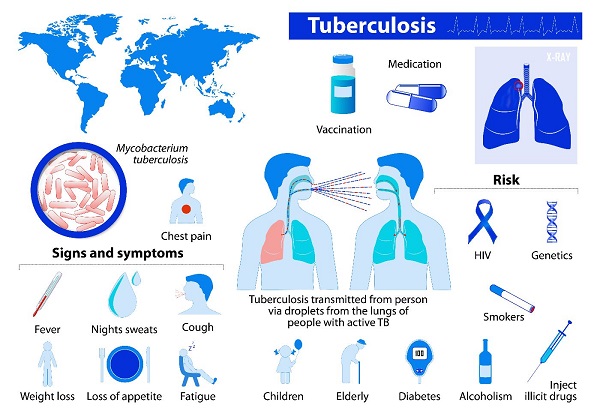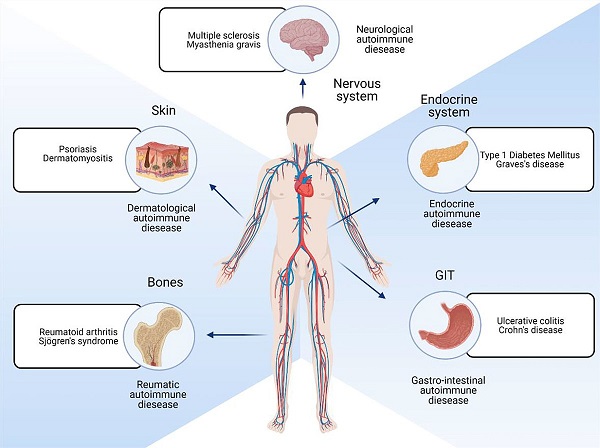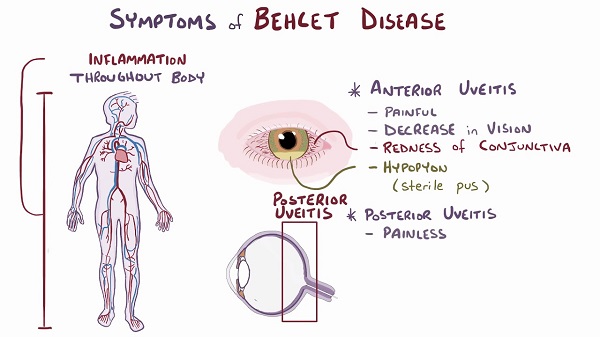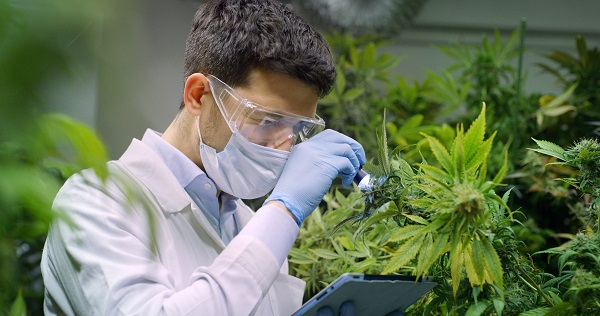There are many diseases whose research is limited due to their rarity and complexity. The use of cannabis can offer comprehensive approaches to the treatment of such conditions (https://www.thelancet.com/journals/laneur/article/PIIS1474-4422(03)00381-8/fulltext). Medical cannabis programs are now helping to find these approaches and make them available to patients who desperately need them.
There is a growing realization that cannabis can help with pain, inflammation or neurodegenerative diseases such as Alzheimer’s and Parkinson’s. However, the true potential of using medical cannabis to treat rare diseases and disorders has yet to be explored. From myasthenia gravis to Behcet’s disease: patients deserve a comprehensive look at new effective cannabis-based therapies. Let’s take a look at what the scientific research says.
Myasthenia gravis

- An autoimmune disease that causes progressive weakening of the skeletal muscles.
- Affects 50 to 200 million people worldwide.
The main signs and symptoms of myasthenia gravis include:
- Drooping eyelids, blurred or double vision and facial features
- Difficulty chewing, swallowing, and speaking
- Difficulty breathing and weakness in the arms, hands, fingers, legs, and neck
Myasthenia gravis is caused by antibodies that attack nicotinic acetylcholine receptors, which interfere with the normal transmission of acetylcholine, the neurotransmitter responsible for coordinating nerve impulses with muscle movements. There is no treatment for myasthenia gravis, but some anticholinesterase agents may have some effect.
Acetylcholinesterase is an enzyme that breaks down acetylcholine, so blocking its action can effectively increase acetylcholine levels at the neuromuscular synapse (the nerve-muscle interface). Increased levels of acetylcholine allow more nerve signals to pass through and enhance muscle responses.
Several studies have shown the ability of THC to block acetylcholinesterase and slow the breakdown of acetylcholine (https://www.ncbi.nlm.nih.gov/pmc/articles/PMC2562334/). One U.S. state, Illinois, lists myasthenia gravis as an approved condition, and Dr. Allan Frankel of California treats myasthenia gravis patients with a mixture of CBD and THC-A, with seemingly positive results (https://unitedpatientsgroup.com/blog/2016/05/27/myasthenia-gravis-cannabidiol-thc).
Tuberculosis

- A rare genetic disorder that causes the growth of benign tumors in the brain, eyes, and other vital organs.
- Global prevalence 7-12 cases per 100,000
- Usually diagnosed in infancy or childhood
Tuberous sclerosis complex (TSC) can lead to autism, epilepsy, developmental delays, behavioral problems, and a variety of other symptoms that vary greatly among individuals.
In TSC, genetic mutations affect the expression of two proteins: gamartin and tuberin. In healthy individuals, these proteins cooperate to regulate various aspects of cell growth, division, and apoptosis. They also function as suppressors of tumor growth. In the case of TSC, these proteins are suppressed, resulting in uncontrolled cell growth and ultimately tumor formation.
The endocannabinoid system is closely related to TSC. Studies have found that children with TSC show abnormally high CB1 receptor expression early in brain development (https://www.sciencedirect.com/science/article/pii/S0306452210009589).
It has been suggested that the endocannabinoid system may play a role in processes related to cell division and apoptosis (https://www.ncbi.nlm.nih.gov/pmc/articles/PMC3863507/). Moreover, cannabidiol (CBD) is a significant anticonvulsant that may reduce seizures in TSC.
However, other treatment approaches are being developed (https://www.researchgate.net/publication/309026988_Cannabidiol_as_a_new_treatment_for_drug-resistant_epilepsy_in_tuberous_sclerosis_complex). GW Pharmaceuticals recently received FDA approval for its CBD-based spray Epidiolex for the treatment of epilepsy caused by Lennox-Gastan syndrome and Dravet syndrome. While this is great news for the development of needed treatments, some have criticized the drug because of its high cost (https://www.fda.gov/news-events/press-announcements/fda-approves-first-drug-comprised-active-ingredient-derived-marijuana-treat-rare-severe-forms).
Mitochondrial disease

- A group of genetic diseases affecting the mitochondria, the energy “engines” of cells.
- Global prevalence is about 11-12 per 100,000
- Children born with mitochondrial disease usually show symptoms by age 10.
Mitochondrial disease can cause various neurological disorders such as seizures, chronic pain, muscle weakness, visual and hearing impairment, as well as learning problems, multi-organ disease and respiratory disorders.
Patients with mitochondrial disease claim that cannabis oil greatly improves seizure control and relieves chronic pain. Because of this, the U.S. state of Georgia has placed mitochondrial disease on the list of approved conditions for patients allowed to use medicinal marijuana (www.house.ga.gov/Documents/CommitteeDocuments/2018/Low_THC_Medical_Oil_Access/Medical_Cannabis_Update.pdf).
Some studies have shown that the antioxidant properties of some cannabinoids can directly improve mitochondrial function. At this point, however, research on this topic is in its infancy. For a more detailed discussion of existing research, see “Cannabinoid Receptor Agonists Are Mitochondrial Inhibitors (https://www.researchgate.net/profile/Andrzej_Loesch/publication/5912829_Athanasiou_A_et_al_Cannabinoid_receptor_agonists_are_mitochondrial_inhibitors_a_unified_hypothesis_of_how_cannabinoids_modulate_mitochondrial_function_and_induce_cell_death_Biochem_Biophys_Res_Commun_/links/53d277350cf228d363e942f8.pdf).
Behçet’s disease

- An autoimmune disease in which the immune system attacks several parts of the body.
- Rare in North America and Northern Europe (1 in 15,000 to 1 in 500,000)
- More common in parts of Asia and Africa (2 in 1,000 in Turkey, the most affected country)
Behçet’s disease can cause skin and genital lesions, swollen joints, chronic pain, cerebral edema, blood clots, and aneurysms. A combination of as-yet-unspecified genetic and environmental factors is thought to cause IBD. There is no known cure, but anti-inflammatory drugs may provide some relief, and immunosuppressants are also used.
Several cannabinoids, including THC and CBD, are known for their anti-inflammatory effects, and some patients with BP in the United States report subjective symptom relief from cannabis use. In the U.S., the state of Illinois has listed BAR as an approved condition (www.dph.illinois.gov/sites/default/files/publications/medical-cannabis-annual-report-idph-10012015-040616.pdf)
Neuromyelitis optica (Devic’s disease)
- A rare autoimmune disease causing recurrent inflammation and demyelination of the optic nerve and spinal cord.
- Global prevalence of 1-2 per 100,000
- Often mistaken for multiple sclerosis (MS), making it difficult to establish prevalence
Optic neuromyelitis (NMO) results in permanent loss of vision and impaired spinal cord function, which can cause muscle weakness, coordination problems, problems with bowel and bladder control, and loss of sensation.

NMO has similarities to multiple sclerosis (MS) because both diseases are characterized by inflammation and demyelination of nerve tissue. However, the mechanism of the autoimmune response is different. NMO can lead to much more rapid physical deterioration, and approximately 30% of patients die within five years of diagnosis. While most people with MS have a normal or slightly shortened life expectancy. There is no treatment for NMO, but some medications can alleviate symptoms.
In a 2013 study (https://journals.plos.org/plosone/article?id=10.1371/journal.pone.0071500) of neuropathic pain and hypersensitivity caused by NMO, patients were found to have elevated levels of the endocannabinoids 2-AG and anandamide compared to a control group of healthy people. The researchers concluded that these endocannabinoids are produced in greater amounts in NMO patients to reduce pain, sensitivity and prevent hyperalgesia.
Ehlers-Danlos syndrome
- A group of genetic diseases affecting the skin and connective tissue of the joints.
- Global prevalence of about 20 per 100,000
Ehlers-Danlos syndrome (EDS) can lead to hypermobility, joint instability, increased skin elasticity, chronic pain, muscle spasms, joint and spine deformities, and cardiovascular complications. SED is caused by mutations in some important genes responsible for the expression of proteins that play a key role in collagen synthesis.
Patients with SED report subjective relief of neuropathic pain and spasms when using cannabis and cannabinoid-based therapies (fox13now.com/2015/12/28/utah-mom-with-rare-disorder-booked-on-marijuana-possession-pushes-for-change-in-state-law/). The component palmitoylethanolamide (PEA) is also used to reduce symptoms of neuropathic pain (marketed under the brand name PeaPure in some countries).
Although PEA is not a classical cannabinoid, it is known to have an affinity for the GPR55 and GPR119 receptors, which are part of the endocannabinoid system, and it is also known to enhance the effects of anandamide through an entourage effect (https://www.ncbi.nlm.nih.gov/pmc/articles/PMC3174079/).
Bubbly
- A rare group of autoimmune diseases affecting the skin and mucous membranes, especially the oral cavity.
- The global prevalence of vesicles is estimated at 10-50 per 100,000 people.
- Some ethnic groups (especially Ashkenazi Jews) are more affected than others
Urticaria causes itching and often painful blisters and sores that can affect most of the body. If left untreated, the condition can cause sudden infections that can be fatal. Conventional treatments include the use of powerful steroids, such as prednisolone, which can cause serious side effects with long-term use.
Vesicles are caused by pathogenic antibodies that attack a protein called desmoglein. Without this protein, epidermal cells cannot adhere properly, and the layers of skin and mucous membranes gradually peel off.
Studies have shown that cannabis-based therapies can be effective against a variety of autoimmune diseases affecting the skin, including psoriasis and bullous epidermolysis. Primarily CB₂-receptors provide the immune and anti-inflammatory effects of cannabinoids, and these receptors are concentrated in the epidermis (https://www.ncbi.nlm.nih.gov/pmc/articles/PMC2768535/).
Also, cannabinoid treatments (especially topical creams and ointments) can have significant antibacterial, antiviral, and antifungal effects, helping to prevent secondary infection. Several patent applications have been filed for topical cannabis-based preparations for the treatment of vesicles, and there are individual cases of patients whose symptoms have improved (https://patents.google.com/patent/US20160272578).
Myoclonus of diaphragm flutter
- An extremely rare condition that causes rapid, involuntary spasms of the diaphragm.
- Only 50 people worldwide have been diagnosed so far
- Also known as belly dancer syndrome
Diaphragmatic flutter myoclonus (DFM) provokes contraction of the diaphragm with a frequency of 35 to 480 times per minute, causing a spasmodic effect resembling a belly dance. This extremely rare condition may be due to an eating disorder, central or peripheral nervous system dysfunction, medication, or even possibly anxiety (https://jmedicalcasereports.biomedcentral.com/articles/10.1186/1752-1947-5-493).
MDF is not usually fatal, but causes discomfort and problems with breathing and eating (gazette.com/teen-says-marijuana-has-been-a-lifesaver/article/134241). There is no standard pharmaceutical treatment, but symptoms can be quickly relieved by temporarily blocking the diaphragmatic nerve that runs through the lungs and reaches the diaphragm.
In one famous case, a young man named Chaz Moore, suffering from MDF, found that medical marijuana was the only effective treatment for his symptoms (https://www.ncbi.nlm.nih.gov/pmc/articles/PMC5767492/). Because of the rarity of the disease, there is little research, but cannabinoids with antispasmodic and anticonvulsant effects, such as CBD, are of most interest.
Familial Mediterranean fever

- Hereditary inflammatory disease, especially affecting the chest, abdomen, and joints.
- Global prevalence is estimated at 10-50 per 100,000; in the most affected areas, the prevalence may be as high as 500 per 100,000 (1 in 200)
- Primarily affects Mediterranean populations, especially Armenians, Greeks, Italians, and Sephardic Jews
Familial Mediterranean fever (FMF) causes bouts of pain, fever, and inflammation in the chest, abdomen, and joints that last several hours and return periodically. In 90% of patients, the first attacks occur before the age of 18, and the diagnosis is usually made by the age of 20 (https://www.ncbi.nlm.nih.gov/pmc/articles/PMC3985156/).
SSL is thought to be caused by mutations in genes that regulate the expression of a protein called pyrin, which is actively involved in the control of inflammation. Analgesics, NSAIDs and some other drugs, including colchicine, can have some effect.
Cannabis was first mentioned as a potential treatment for SLE in 1997 (onlinelibrary.wiley.com/doi/10.1111/j.1365-2044.1997.139-az0132.x/full). A double-blind, placebo-controlled, crossover study conducted on one patient with SSL found that THC significantly reduced the need for opioid painkillers. However, no additional studies seem to have been done.
CDKL5 deficiency disorder

- An extremely rare genetic disorder associated with the X chromosome that causes seizures and developmental delays.
- To date, more than 1,000 cases have been reported worldwide.
- The disease is inherited by the X-linked dominant type
This rare and relatively new disorder causes severe seizures, developmental delay, scoliosis, icrocephaly, motor disorders, restricted speech, and many other anomalies. The disorder is associated with mutations in the CDKL5 gene, which is located on the X chromosome.
Little is currently known about the disorder, and there have been no official studies of cannabis as a treatment. However, reports indicate that some families with the disorder have seen significant improvements after using CBD. In 2014, an 11-month-old girl was reported who showed improvement in muscle control, eye contact, alertness and overall progress after using CBD (www.dailyfreeman.com/general-news/20140418/kingston-baby-with-rare-genetic-disorder-undergoes-medical-marijuana-treatment-in-colorado).
In 2016, 6-year-old Harper Elle Howard tragically passed away after failing to beat CDKL5. She began having life-threatening seizures at only two weeks of age that were not amenable to standard treatments (https://www.huffpost.com/entry/hope-for-harper-how-a-lit_b_8993830).
Use of CB resulted in rapid and significant seizure reductions and allowed Harper to return to a post-normal development over a period of several years. However, the struggle to maintain normalcy eventually became too much for Harper, although her story served as a direct impetus for changes in medical cannabis legislation in several countries (https://www.researchgate.net/publication/233294071_Cannabinoids_and_Cystic_Fibrosis).
Of course, these are not the only rare conditions for which cannabis can help. There are many disorders and diseases for which it can help and requires further research. Cystic fibrosis is just one of them. Although there is not really any research showing its effectiveness or exactly how it can help, there are thoughts in the medical community about its capabilities.












